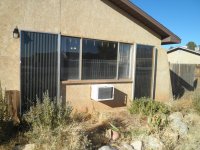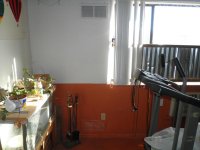dogman dan
1 PW
Re posting this because it's cold time again, and the original thread is buried from years ago, before the alternative energy section was made. This might not work so great in the far north, but here on the Mexico border we get lots of great sun even in winter. About 6 hours a day of noticeable heat is produced. On bitter cold cloudy days, though it may be useless to open the vents, it still keeps a part of the wall warmer, lessening the heat loss on the cold day.
The idea is similar to a trombe wall, but set up more like a heat exchanger instead of a heat storage. Here is my south southeast facing front wall of the house. Off to a good start already with a 4'x8' window that gathers sun nicely. On either side are 3'x6'8" used sliding glass door panels. Freebie of course, but they can be bought at most flea markets. Inside each panel is a sheet of steel roof painted black. Here is the wood framework, screwed to the wall and caulked, to make a space for the metal panel behind the glass.
Off to a good start already with a 4'x8' window that gathers sun nicely. On either side are 3'x6'8" used sliding glass door panels. Freebie of course, but they can be bought at most flea markets. Inside each panel is a sheet of steel roof painted black. Here is the wood framework, screwed to the wall and caulked, to make a space for the metal panel behind the glass.  The tree in the reflection is perfectly placed to shade the window in summer, but the sun shines under the branches all winter.
The tree in the reflection is perfectly placed to shade the window in summer, but the sun shines under the branches all winter. 
Inside the window is some more steel roof, with the top still open to see outside. Great view of the nearby Organ mts I want to still see. The black metal definitely gets hotter than other surfaces the sun might otherwise hit, and the hot metal radiates the heat back into the room nice. Still get plenty of light since the window is big. View attachment 4
Where the panels are attached to the wall on either side of the window, there are vents cut through the wall that allow air to circulate by convection all day. At night, they have to be covered to prevent them from convecting cold air all night. So I use magnetic covers made from cardboard and flexy magnetic strip. All day when the sun shines, heat pours out the upper vent, and cold floor air sucks into the lower vent.
Any day it reaches 50F, and the sun shines, It will warm the living room and kitchen to 70F. The window by itself would only heat the room to about 60.
I also modified the front porch. The iorn barred door was removed and replaced with a storm door, then the remaining iron was covered with easy to cut panels intended to be light fixture diffusers. View attachment 1
Inside, I keep a bit of summer going in there all winter. On a warm day I can gather some heat here too, but mostly it just keeps a bit of my exterior wall warmer than normal. Eliminates freezing drafts through the front door weather strips. I'll get a few tomatoes for another month or so, till it starts just reaching 32 in there at night. The panzies will keep blooming all winter, and stink up the place with spring smells in January. By february, hell, it's spring here and I can start next years tomatoes in the porch.
The idea is similar to a trombe wall, but set up more like a heat exchanger instead of a heat storage. Here is my south southeast facing front wall of the house.
 Off to a good start already with a 4'x8' window that gathers sun nicely. On either side are 3'x6'8" used sliding glass door panels. Freebie of course, but they can be bought at most flea markets. Inside each panel is a sheet of steel roof painted black. Here is the wood framework, screwed to the wall and caulked, to make a space for the metal panel behind the glass.
Off to a good start already with a 4'x8' window that gathers sun nicely. On either side are 3'x6'8" used sliding glass door panels. Freebie of course, but they can be bought at most flea markets. Inside each panel is a sheet of steel roof painted black. Here is the wood framework, screwed to the wall and caulked, to make a space for the metal panel behind the glass.  The tree in the reflection is perfectly placed to shade the window in summer, but the sun shines under the branches all winter.
The tree in the reflection is perfectly placed to shade the window in summer, but the sun shines under the branches all winter. Inside the window is some more steel roof, with the top still open to see outside. Great view of the nearby Organ mts I want to still see. The black metal definitely gets hotter than other surfaces the sun might otherwise hit, and the hot metal radiates the heat back into the room nice. Still get plenty of light since the window is big. View attachment 4
Where the panels are attached to the wall on either side of the window, there are vents cut through the wall that allow air to circulate by convection all day. At night, they have to be covered to prevent them from convecting cold air all night. So I use magnetic covers made from cardboard and flexy magnetic strip. All day when the sun shines, heat pours out the upper vent, and cold floor air sucks into the lower vent.

Any day it reaches 50F, and the sun shines, It will warm the living room and kitchen to 70F. The window by itself would only heat the room to about 60.
I also modified the front porch. The iorn barred door was removed and replaced with a storm door, then the remaining iron was covered with easy to cut panels intended to be light fixture diffusers. View attachment 1
Inside, I keep a bit of summer going in there all winter. On a warm day I can gather some heat here too, but mostly it just keeps a bit of my exterior wall warmer than normal. Eliminates freezing drafts through the front door weather strips. I'll get a few tomatoes for another month or so, till it starts just reaching 32 in there at night. The panzies will keep blooming all winter, and stink up the place with spring smells in January. By february, hell, it's spring here and I can start next years tomatoes in the porch.






